
About UsThe Numismatic Bibliomania Society is a non-profit organization promoting numismatic literature. For more information please see our web site at coinbooks.org SubscriptionsThose wishing to become new E-Sylum subscribers (or wishing to Unsubscribe) can go to the following web page link MembershipThere is a membership application available on the web site Membership Application To join, print the application and return it with your check to the address printed on the application. Membership is only $15 to addresses in the U.S., $20 for First Class mail, and $25 elsewhere. For those without web access, write to: David M. Sundman, Secretary/TreasurerNumismatic Bibliomania
Society AsylumFor Asylum mailing address changes and other membership questions, contact David at this email address: dsundman@LittletonCoin.com SubmissionsTo submit items for publication in The E-Sylum, just Reply to this message, or write to the Editor at this address: whomren@coinlibrary.com
BUY THE BOOK BEFORE THE COINYou won't regret it! |
- WAYNE'S WORDS: THE E-SYLUM JUNE 16, 2013
- ARTEMIDE XXXVIII NUMISMATIC LITERATURE AUCTION
- NEW BOOK: ESTONIAN COINS AND BANKNOTES
- NEW BOOK: NUMISMATICS OF LATE SASANIAN KINGS
- COLORADO SPRINGS FIRES RETURN
- GEORGE A. MERZ, 1939-2013
- WASHINGTON POST OBITUARY OF RICHARD G. DOTY
- FURTHER READER REMARKS ON RICHARD G. DOTY
- NOTES FROM E-SYLUM READERS: JUNE 16, 2013
- MORE ON JIM KELLY AND HIS COINS AND CHATTER
- JUNE 2013 WHITMAN COIN EXPO PRESENTATIONS
- NEWMAN EARLY U.S. DOLLARS SUBJECT OF BALTIMORE TALK
- QUERY: V. M. HANKS AND RICHARD NELSON INFORMATION SOUGHT
- QUERY: INFORMATION ABOUT JANVIER'S PARTNER BERCHOT SOUGHT
- THE MYSTERIOUS LARGE CENT LADY OF 1954
- THE BUSHNELL SALE OF 1882
- MORE ON THE DRAKE MERCATOR MAP MEDAL
- ARTICLE REVIEWS NEW TOWER OF LONDON MINT EXHIBIT
- LINCOLN CIPHERING BOOK LEAF DISCOVERED
- WAYNE'S NUMISMATIC DIARY: JUNE 16, 2013
- PITTSBURGH CHRONICLE TELEGRAPH TOKEN FOUND
- DOG WALKER FINDS 1870-CC DOUBLE EAGLE IN DIRT
- FALKLANDS ISLANDS MARCH REFERENDUM COIN
- WORK CONTINUES ON CELTIC COIN HOARD FOUND IN JERSEY
- ALASKA'S FORT KNOX GOLD MINE
- AN AUSTRALIAN MAN'S SHOCKING STATIC JACKET
- FEATURED WEB PAGE: BUSHNELL BAS-RELIEF BY A. W. JONES
WAYNE'S WORDS: THE E-SYLUM JUNE 16, 2013

No new subscribers this week. We have 1,648 email subscribers, plus 234 followers on Facebook.
Happy Father's Day, Dads! My afternoon was spent with the whole family watching the animated film Epic. After a great restaurant dinner and dessert I came home to play basketball and a couple games of Monopoly before the kids' bedtime. Now I'm working on The E-Sylum before calling it a night. It was a good day.
This week we open with a numismatic literature sale and a couple new or recent books on world numismatics. Other topics include the fires in Colorado Springs, the Drake Mercator Map medal, and Alaska's Fort Knox.
To learn more about Jim Kelly and the first editor of Coin World, the Bushnell sale of 1882, the First National Oyster Bank, Eric Newman's early U.S. dollars, the Mysterious Large Cent lady, and why it's a bad idea to wear a nylon jacket with a wool shirt, read on. Have a great week, everyone!
Wayne Homren
Editor, The E-Sylum
ARTEMIDE XXXVIII NUMISMATIC LITERATURE AUCTION
Eric Vanhove writes:
The Artemide XXXVIII auction on July 23 is a numismatic book auction. It requires a little bit of pigeon Italian to understand, but there are lots of books.
To access the online catalog, see: Artemide Aste XXXVIII - Libri (www.deamoneta.com/auctions/home/149)
NEW BOOK: ESTONIAN COINS AND BANKNOTES
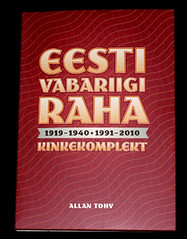 Publication, “EESTI VABARIIGI RAHA” 1919 to 1940 and 1991 to 2010 complete.
Publication, “EESTI VABARIIGI RAHA” 1919 to 1940 and 1991 to 2010 complete.
By Allan Tohv. Softcover – 50 placards included
ISBN number: 978-9949-30-126-3
Estonian Language first print, 2011.
From the author of several publications focusing on the coins and banknotes of Estonia, Allan Tohv, a leading expert on the subject, has released a new informative and practical publication which includes illustrations of all the coins and paper money issued by the Republic of Estonia since independence in 1918.
Concentrating specifically on the illustrations, the collection of images are brought together in a functional tri-folder presentation whose format cleverly divides these issues from the first and second periods of Estonian nationhood. On one side of the folder, the coins and banknotes from Estonia’s first era of independence which covers the marka coins issued in 1922 right up to the last krooni & senti coins issued in 1939. The placards are cleverly printed (and exactly aligned) on both sides in full color and illustrating obverse and reverse images in clear depictions. Also included are images of Estonia’s first payment notes issued in 1919 (50 Marka) fidelity notes, treasury notes (1919 – 1923) - the pre-cursor to eventual banknotes issued by the Bank of Estonia beginning in 1928.
The second side includes both the circulation and commemorative coins issued by the Bank of Estonia since the restoration of Independence in 1991. The first coins, also dated that year are illustrated as well as the first silver commemorative coins issued for the 1992 Summer Olympics. Images for the gold and silver collector coins dated 2010 which mark the introduction the Euro are also included. Estonia’s beautiful and colorful banknotes highlighting prominent Estonian personalities were introduced in June 1992 (with notes dated the year before) in denominations from 1 to 500 Krooni. This series along with a revised series including the 25, 100 and 500 Krooni notes continued as Estonia’s legal tender until the introduction of the EURO single currency in January 2011. Images for the series of banknotes, those dated 1991, 1992, 1994, 1996, 1999, 2000, 2002, 2006 and 2007 are all comprehensively included.
To read the complete article, see: New Publication on Estonian Coins and Banknotes (news.coinupdate.com/new-publication-on-estonian-coins-and-banknotes-2025/)
NEW BOOK: NUMISMATICS OF LATE SASANIAN KINGS
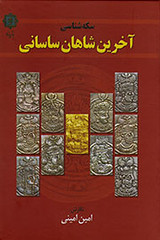 Numismatics of Late Sasanian Kings written by Amin Amini makes a historical survey of currency and numismatics during the Sasanian era.
Numismatics of Late Sasanian Kings written by Amin Amini makes a historical survey of currency and numismatics during the Sasanian era.
The book is organized in three chapters: “General View of Latest Sasanian Coins”, “The Last Sasanian Kings”, and “The Interregnum Period”.
The first chapter includes general issues like numismatic studies, a collection of the Sasanian mints and introduction of new ones that are discussed under the headings ‘Date Inscription in Sasanian Coins’, ‘City – The Place of Sasanian Mints’, and ‘Abridged Named of Mints in Latest Sasanian Coins’.
The second chapter offers a history of nine Sasanian kings whose reigns and spans of life are recorded on the coins, including Hurmoz V, Ardesheer III, Qobad II, Bouran, Khosrow III, Hurmoz VI, Azarmeidokht, Khosrow IV, and Yazdgerd III.
The last chapter then provides and conclusion and the events following the death of Yazdgerd that affected the functioning of mints.
The research method is based on numismatic documents and their historical context and finally the author has estimated the lifespan of each Sasanian king based on numismatic analyses. The book also features pictures of the analyzed coins.
The first print of ‘Numismatics of Late Sasanian Kings’ written by Amin Amini is published in 200 pages and 1000 copies by Pazineh Publications.
To read the complete article, see: Book on Sasanian Numismatics published (www.ibna.ir/vdcae6n6i49n0e1.tgk4.html)
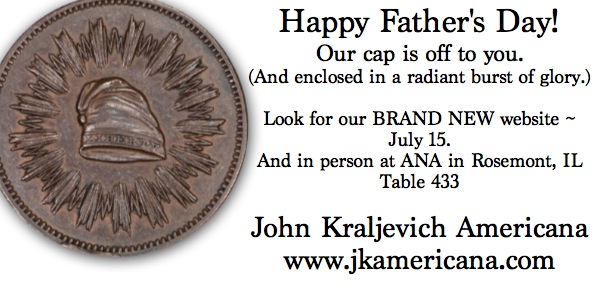
COLORADO SPRINGS FIRES RETURN
Bill Rosenblum of Littleton CO writes:
I'm writing to warn those who are coming to Colorado Springs for the upcoming ANA Summer Seminar that Colorado is again experiencing hot, dry and windy weather. On Tuesday a fire blew up in the Black Forest Area which is northeast of Colorado Springs. At the moment 100 or more homes have been destroyed. I know at least one numismatist who lives in the middle of the evacuated area and I hope and pray he and his family are ok. Ironically he is a Colorado Springs Fire Fighter.
The mailing addresses of all those homes in unincorporated El Paso County have Colorado Springs Zip Codes/ I presume there are more than a few other numismatists who live near there. Steve D’Ippolito, who is running for ANA Board, lives near there but hopefully far enough east of the fire-ravaged area. Those who visit, please be very careful of fire and right now the air, even 50 miles NW of the fire, is very smoky.
I learned on Friday that at least one coin dealer lost everything but his life in the fire. Dave Bayuk - his dream house which he just bought last November when he retired burned to the ground. Everything gone. Had to run to get out of harm's way. All is gone: wallets, driver's license, cash, files, business records, and everything he moved from the basement of his old business.
Today, Ken Hallenbeck writes:
The fire didn't come any closer to the ANA than 7 or 8 miles. The air quality was pretty bad at times, but if you were inside and air conditioned, it wasn't too bad. I guess if you had some respiratory or lung problems, it could have been pretty bad, but haven't heard of anyone with problems.
By the time the ANA summer seminar gets going, the air quality should be just fine. My son Tom's house was in an area designated as "Pre-evacuation." This was defined as "ready, get set. and go." Since Tom and family are in Germany (they get back Tuesday), several of us went to his house and loaded his cars with what we thought was meaningful or valuable and got it over to my area which was quite removed from any immediate danger. In the end, it would not have been necessary, since his area in now removed from any evacuation notice. But, how could we foresee this? Better safe than sorry.
We had a few customers who were evacuated, but haven't heard of any losses. Leonard Albright, who was formerly ANACS chief and worked at PCGS, and now works part time with us was forced to evacuate. But went back to his place last night.
A former coin dealer, Dave Bayuk, who recently retired had built the house of his dream in Black Forest. He had just recently moved in. His house was a total loss, and he barely made it out alive. A lady who worked for him for a number of years came to us when he retired has kept in touch with him. I've no idea whether he had anything numismatic in his house.
That brings to mind the fact that after the Waldo Canyon fire a year ago, almost to the day, we've bought some damaged and even melted coins, jewelry and sterling flatware. It is so sad/ It's a heck of a way to do business.
After the Waldo fire of a year ago a couple came in to our store and sold us some items. As part of our procedure, we get their driver's license, fill out a form, require them to fill out a form, etc. The form gets turned in weekly to the police. Well, they get a copy which they retained. Somehow the police got them, they still had the form (dumb). The police asked us if we had bought things from them, which we said we had. We gave the police a copy of the video disc, and later, Chad, one our employees, appeared as a prosecution witness. One got 48 years and the other 24 or so. We lost $80 on the deal, but it was worth it to get those looters sent to jail. They were both previous offenders.
I'm looking forward to the ANA summer seminar. It is always interesting and fun. Besides, I see a lot of old as well as new friends in a relaxed atmosphere as opposed to the hustle and bustle of a coin show.
To read the earlier E-Sylum article, see: COLORADO SPRINGS FIRES AFFECT LOCAL AND VISITING NUMISMATISTS (www.coinbooks.org/esylum_v15n27a02.html)
GEORGE A. MERZ, 1939-2013
Eric Schena writes:
George A. Merz, Treasurer of the Virginia Numismatic Association, passed away on 5 June 2013. George has been a big supporter of spreading and encouraging knowledge on numismatics in the Commonwealth and helped me tremendously in putting out my book on Ingle System scrip. He was a fixture at many coin shows in the area and always willing to talk about history and numismatics. He and Judy have always been kind and generous and absolute joys to be around. I will miss him dearly.
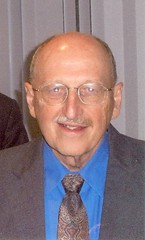 George Albert Merz, 73, of Bridgewater, passed away June 5, 2013 at his residence in Bridgewater.
George Albert Merz, 73, of Bridgewater, passed away June 5, 2013 at his residence in Bridgewater.
Mr. Merz was born June 14, 1939 in Buffalo, New York, and was the son of the late Walter Merz and Elizabeth Bertsch Merz. Mr. Merz received a B.S. Degree in Pharmacology from the University of Buffalo, and attended Virginia Commonwealth University, studying accounting. He passed his CPA exam and practiced briefly. He also held a Master Gardener Certification.
To read the complete obituary, see: George A. Merz (www.kygers.com/current-obituaries-topmenu-38/92-june-2013/1981-george-a-merz)
WASHINGTON POST OBITUARY OF RICHARD G. DOTY
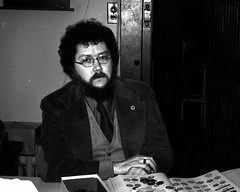 Richard G. Doty, a scholar of money who helped humanize coins and currency by showing how the objects might reflect the culture, values and history of a society, died June 2 at the Powhatan Nursing Home in Falls Church. He was 71.
Richard G. Doty, a scholar of money who helped humanize coins and currency by showing how the objects might reflect the culture, values and history of a society, died June 2 at the Powhatan Nursing Home in Falls Church. He was 71.
At the time of his death, Dr. Doty was the senior numismatic curator at the Smithsonian Institution’s National Museum of American History. “He was really a historian, more than a numismatic,” said Ute Wartenberg Kagan, executive director of the American Numismatic Society. “He interpreted the coins, and that made him very special.”
William E. Metcalf, curator of coins and medals at the Yale University Art Gallery, called Dr. Doty “a great popularizer of the discipline” through his nine books and several hundred scholarly articles.
Dr. Doty was considered one of the top numismatists in the world because he was both a specialist in the field of minting and printing technologies and a general expert on all things coin- and currency-related, particularly the objects’ places in history.
Most numismatists specialize in a geographical area or a certain time period, but Dr. Doty’s “Renaissance personality” drove him to learn everything he could about coins and paper money and what stories they told about their time periods, said Karen Lee, a curator with the Smithsonian’s National Numismatic Collection and a colleague of Dr. Doty’s for 10 years.
“I have never seen anybody do that before,” Lee said. “You could ask him a question about anything, literally anything.”
Richard George Doty was born in Portland, Ore., on Jan. 11, 1942. His interest in coins began at 8, when he got hold of Japanese and Chinese coins brought back from World War II.
His collection grew from there. He added Indian rupees and some private Chinese bank notes from the early 20th century that he obtained from a childhood friend, but he said that he preferred coins.
“Old coins are as much antiques, works of art, as Chippendale chairs or paintings by Rubens,” Dr. Doty told the Times in 1978. “They afford us fascination and great pleasure, and they are within the reach of everyone.” He added that coins are “perhaps the easiest and best way of getting into the past, of learning about other peoples, places, and times.”
Post web site reader "HistoryRhymes" wrotes:
What this obituary omits is a sense of Dr. Doty as a person. Dick was playful, fun, and loved his job. He even complained in good humor. While it would have been well within his rights to play the haughty academic, he was incredibly down to earth, enjoying good company and genuine intellectual curiosity with average collectors as much as famed experts. He was a careful researcher, a generous colleague, and a master practitioner of language in all of its forms. The world has known a lot of brilliant curators and gifted numismatists, but there will never be another remotely like Dr. Doty.
To read the complete article, see: Richard G. Doty, money expert and Smithsonian curator, dies at 71 (www.washingtonpost.com/national/richard-g-doty-money-expert-and-smithsonian-curator-dies-at-71/2013/06/07/973a469a-cedb-11e2-8845-d970ccb04497_story.html)
THE BOOK BAZARRE
FURTHER READER REMARKS ON RICHARD G. DOTY
Harold Levi writes:
I am shocked and deeply saddened to learn of Richard Doty's passing. My condolences to his family!
Although we never met, he was a great help to me in my research of the Bashlow Confederate cent restrikes. I needed photos of the dies Bashlow donated to the Smithsonian Institution. I explained my need and why and he responded almost immediately. He said that he would have to locate the dies and that it may take some time.
Expecting weeks if not months, a couple of days later he sent an e-mail stating that he had found the dies and would take photos of all. Expecting days if not weeks, within hours he started sending the images, all twelve of them.
When I tried to thanked him he would just respond; Cheers D.
Philip Mernick writes:
Dick Doty was good friend of The London Numismatic Club. He spoke to our club on several occasions when visiting England, and we were delighted to host such a prestigious lecturer. His genial personality will be much missed.
Bill McKivor writes:
I used to talk to him a couple times a week. I wish now I had saved some of the very funny E-mails he used to send, we did that almost daily, cannot get over not having him around. He made me smile, and I always learned something. We had really become close friends, for me one of a couple, and I think for him, one of many.
To read the earlier E-Sylum article, see: MORE TRIBUTES TO RICHARD DOTY (www.coinbooks.org/esylum_v16n24a07.html)
NOTES FROM E-SYLUM READERS: JUNE 16, 2013
Another ANA Peter Max Print
Gar Travis writes:
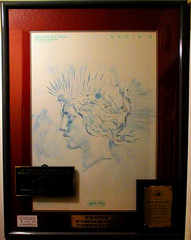 For what it is worth, I have one of the ANA Peter Max prints and mine is signed by the artist. It is slightly different and I suspect it was a show "issued" example. It was a gift from then (2004) Teletrade vice president Ian Russell. It hangs in my hall and mounted upon the plexiglass frame are some items of my life before coming to work in California in 2004.
For what it is worth, I have one of the ANA Peter Max prints and mine is signed by the artist. It is slightly different and I suspect it was a show "issued" example. It was a gift from then (2004) Teletrade vice president Ian Russell. It hangs in my hall and mounted upon the plexiglass frame are some items of my life before coming to work in California in 2004.
To read the earlier E-Sylum article, see: NOTES FROM E-SYLUM READERS: JUNE 9, 2013: ANA Peter Max Print's Donor Identified (www.coinbooks.org/esylum_v16n24a10.html)
The American Scale of Token Sizes
Dave Stone of Heritage writes:
Regarding Tom Sheehan's question about the scale used for the token size in the Chubbuck catalog, Haseltine specified it was "... the American scale of sixteen to an inch." Thus size 20 equals 20/16"= 1 1/4" (or 1.25 inches).
To read the earlier E-Sylum article, see: NOTES FROM E-SYLUM READERS: JUNE 9, 2013 : Query: Token Size Listing Sought (www.coinbooks.org/esylum_v16n24a10.html)
More on Action Comics #1
Gary Dunaier writes:
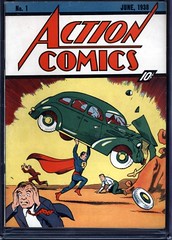 The Action Comics #1 that was found among insulation sold for $175,000.
The Action Comics #1 that was found among insulation sold for $175,000.
One important point that wasn't mentioned: the reason discoverer David Gonzalez' "grab of the issue from his wife's relative's hands ended up downgrading the value on a 10-point scale from 3.0 to 1.5" was because the back cover was torn in the process.
A few interesting "fun facts" about Action Comics #1:
1) The first appearance of Superman was just one of eleven features in the magazine.
2) The very first Superman story ended on a cliffhanger - it was "continued next issue."
3) Action Comics #1 had a coloring contest which required entrants to tear out the last page of the Superman story in order to enter. (The other side of the last page of the Superman story was the first page of a feature that was printed in black and white, and prizes were awarded based on how well entrants colored that page.)
Source for the final price of the Action Comics #1: www.comicconnect.com/bookDetail.php?id=499550
To read the earlier E-Sylum article, see: GREAT FIND: FIRST SUPERMAN COMIC BOOK WAS USED AS INSULATION (www.coinbooks.org/esylum_v16n24a15.html)
MORE ON JIM KELLY AND HIS COINS AND CHATTER
Dave Hirt writes:
I would like to thank all the readers who responded to my questions on Kelly's Coins and Chatter.
After I sent my submission, I found I did have the first auction sale of 1959, the Cincinnati sale. It was filed in a different place. Although printed in the Coins and Chatter format, that name is not mentioned. The edition of Gengerke that I looked at also didn't list it as a Coins and Chatter sale. So, I guess with that sale, and the issue in Hobbies magazine, you could toss a coin to see whether to include them. The second 1959 sale is Coins and Chatter, and is missing from my set. Thanks again for the information.
Dick Johnson writes:
The listing of Kelly's Coins and Chatter by Tom Wetter in last weeks issue, and comments by Dan Hanelberg, David Gladfelter and David Fanning brought back fond memories of both Jim Kelly and his house organ.
As a first-year college student I sent Jim filler items I wrote from combing the pages of Frey's Dictionary of Names. I thought certain ancient coin names were curious and wrote about these. Jim published some of these in his C&C. I can't remember what else I wrote, but these were probably in the 1949 issues.
My first job out of college was with a printer in Dayton, Reynolds and Reynolds. I became fast friends with Jim., who was a nationally known coin dealer in Dayton.
I left Dayton for a newspaper job back in Kansas City. Jim remembered me, my interest in writing, and my newspaper connection when the publisher of the Sidney newspaper (20 miles north of Dayton) was looking for an editor of a weekly coin publication..
His recommendation got me the position. I responded by recommending him to be Coin World's "Trends" contributor.
To read the earlier E-Sylum articles, see:
QUERY: KELLY'S COINS AND CHATTER SET
(www.coinbooks.org/esylum_v16n22a09.html)
MORE ON KELLY'S COINS AND CHATTER
(www.coinbooks.org/esylum_v16n24a08.html)
THE BOOK BAZARRE
JUNE 2013 WHITMAN COIN EXPO PRESENTATIONS
Beth Deisher Presents “Cash in Your Coins”
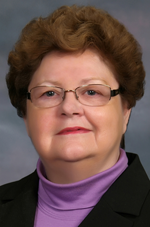 Join award winning journalist and retired editor of Coin World, Beth Deisher at 1 p.m., Saturday, June 22 in room 331. She’ll speak about Cash in Your Coins: Selling the Rare Coins You’ve Inherited.
Join award winning journalist and retired editor of Coin World, Beth Deisher at 1 p.m., Saturday, June 22 in room 331. She’ll speak about Cash in Your Coins: Selling the Rare Coins You’ve Inherited.
This presentation is for anyone who’s inherited a collection (or hoard) of old coins.
Deisher will show you how to identify what you own, how to create an inventory, how to pick out extra-valuable coins, how to value a large estate, and other important and valuable lessons.
Every coin collector should keep a copy of this book with their collection, to help their loved ones make smart decisions when the time comes to sell. The book will be available for sale before the program, and immediately following it Deisher will be available to autograph her book.
To read the complete article, see: http://expo.whitman.com/news/beth-deisher-presents-cash-in-your-coins/
Encore Presentation: “The Private Sketchbook of George T. Morgan”
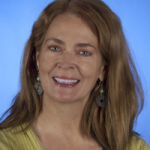 Karen M. Lee is the fifth speaker in the Maryland State Numismatic Association annual Distinguished Lecturer Series. She’s a numismatic researcher and associate curator of the National Numismatic Collection at the Smithsonian Institution.
Karen M. Lee is the fifth speaker in the Maryland State Numismatic Association annual Distinguished Lecturer Series. She’s a numismatic researcher and associate curator of the National Numismatic Collection at the Smithsonian Institution.
Among her many numismatic activities, Karen taught a graduate course, Exhibit Planning and Evaluation, in India to Masters degree candidates in the public communication of science. She is an occasional guest contributor to Coin World, and has published a number of articles on visitor behavior in museums. She created the Smithsonian traveling coin program in which a display is brought to participating museums. Karen escorted a 1933 double eagle to seven different countries for display. She has planned numerous exhibits. She is now involved in planning a new numismatic gallery at the National Museum of American History of the Smithsonian Institution.
Karen’s book is The Private Sketchbook of George T. Morgan, America’s Silver Dollar Artist. Her talk is taken from the book and is titled “The Private Sketchbook of George T. Morgan.” It will be presented on Friday, June 21, at 2 p.m. in room 330 of the Baltimore Convention Center during the Whitman Coin & Collectible Baltimore Expo.
To read the complete article, see: http://expo.whitman.com/news/encore-presentation-the-private-sketchbook-of-george-t-morgan/
Additionally, anyone interested in ancient coins will want to attend “Introduction to Medieval Coins: From the Fall of Rome to the Renaissance” with Mike Markowitz.
The complete show schedule is here: http://expo.whitman.com/baltimore-summer-expo/schedule/
NEWMAN EARLY U.S. DOLLARS SUBJECT OF BALTIMORE TALK
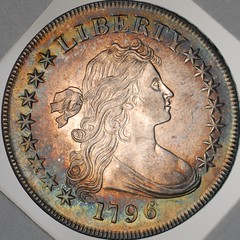
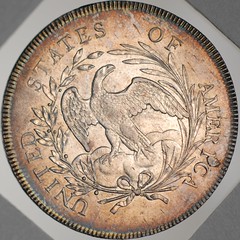
Come view a presentation on the Eric P. Newman Collection of Early U.S. Silver Dollars from 1794 to 1803 in Baltimore – Members of John Reich Collectors Society (JRCS) and Non-members are welcome to attend.
W. David Perkins, JRCS Treasurer and Early Dollar Specialist will be hosting the JRCS Regional Meeting at the Whitman-Baltimore Expo. The meeting will be held from 4:00-5:00pm on Friday, June 21 in Room 330 in the Baltimore Convention Center.
Members and non-members are welcome to join JRCS and view a presentation by W. David Perkins on the extraordinary Eric P. Newman Collection of Early U.S. Silver Dollars from 1794 to 1803. This Date and Major Type Set of early dollars was hand-picked from the Col. E.H.R. Green collection in the 1940s. All of these dollars are high grade and are the majority are beautifully toned from storage in Waite Raymond holders since at least the 1940s.
The collection was studied and these photos were taken in St. Louis in December 2007 by Rory Rea (exceptional photographer and early U.S. Quarter Dollar expert and author) and W. David Perkins, early dollar specialist, researcher, author and collector. Dave and Rory presented the Newman Collection of early dollars 1794-1803 and early quarter dollars 1796-1838 at the JRCS Meeting at the 2008 Baltimore ANA Convention to a standing room only audience.
Photos of the Neman Collection of early quarter dollars 1796-1838 are not part of the JRCS meeting presentation but will be available for viewing in Baltimore. Please see W. David Perkins if you would like to view these photos during the meeting or show - on Thursday and Friday only. Dave can be contacted at wdperki@attglobal.net prior to the show if you have any questions or would like to arrange to view the photos at the show.
QUERY: V. M. HANKS AND RICHARD NELSON INFORMATION SOUGHT
1) V. M. Hanks Jr. (1921-1997) -- a photographer by trade, lived in San Francisco, wrote some articles for Numismatic News, World Coin News and Coins Magazine in the 1970's and 1980's (sometimes also with his wife's name, Nadine). Does anyone know his full name?
2) Richard Nelson -- Los Angeles area coin dealer who organized the first Hong Kong coin show in the 1980's, operated under the name Money Company. The first Money Company auction was in June 1978. His first fixed price list under the name Econo Coin was issued in 1976 or early 1977.
What was he doing before that time? The next to last Money Company auction (#26) in November 1993 is labeled his 25th anniversary sale. That would put his start in the coin business in 1968. In 1992 or 1993 he started "The Collectors Mint" to produce .999 silver rounds. Does anyone know what he has been doing the past few years? Last year I heard he was seriously ill
QUERY: INFORMATION ABOUT JANVIER'S PARTNER BERCHOT SOUGHT
Web site visitor Bill Corser writes:
I have been looking for information about Mr Berchot, whose name was attached to the great medallist Janvier. I have found articles in The E-Sylum from 2004 and 2011 about the firm, and followed the link to the WordPress site, which gives lots of information about Janvier, but I am hoping that you can give me a lead to where I can find more about Berchot. He seems to be a man of mystery, as far as Google is concerned!
To read the earlier E-Sylum articles, see:
WHO WAS DUVAL?
(www.coinbooks.org/esylum_v07n13a10.html)
MORE ON VICTOR JANVIER
(www.coinbooks.org/esylum_v14n41a21.html)

THE MYSTERIOUS LARGE CENT LADY OF 1954
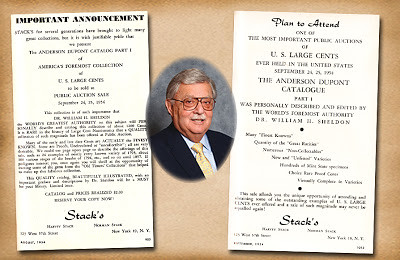
As noted in early stories about the 1954 auction sales of large cents from the Davis Graves and Anderson Dupont collections, much excitement occurred in the collecting world at the news of these two collections.
The first sale, the David Graves Collection, took place in April 1954. Even before the catalogs were issued, large cent collectors were calling to schedule times to visit our offices for private or semi-private showings. We accommodated as many as we could and of course we offered long viewing for those who came to New York from all over to examine and make notes on the coins. Dr. Sheldon let the large cent community know what he was working on and helped attract interest that way. He had a group of collectors who were figuring out among themselves how the coins could be split between them, including pieces that Dr. Sheldon wanted for himself.
The afternoon before the sale began, while coin viewing was still going on, a charming lady came into the exhibit room and went to register to bid. She spoke to our head office manager, at the time Rose Zelman, who had been with Stack’s for close to a decade. At the time we used bidders’ initials instead of bidder numbers, as it was easier for the auctioneer to identify the bidder. The lady identified herself to Rose as Dora Nelson and Rose assigned her the bidder ID of DN. Since we did not know her, she gave us a substantial deposit against the bids she might make. She then went into the exhibit area to review the lots. Before the end of the day, Rose introduced her to me and I introduced her to my father and my uncle.
The next day, about 15 minutes before the start of the auction, DN came into the auction room and sat down on the right side, near the side door. She opened her catalog and waited patiently for the sale to begin. I went over to greet her and offer any help she might need. She smiled and said nicely, “Harvey, this is not the first sale I have ever attended.” I thanked her again for coming and went to my position at the auction block.
The room was filled with 200+ collectors, dealers and agents. Having looked at the mail order bid book earlier in the day, there were enough substantial bids received that the sale was already a success. As an auctioneer, the level of competition is important -- the more there is, the more items sell for.
As the first lot opened, the bidding was room-wide, strong not only from the “Dr. Sheldon” group, but also from all over. As the bidding slowed, all of a sudden DN raised her pen and bid, which she continued to do until she won the lot. All eyes turned her way, and you could hear the murmur of people wondering, “Who is that lady?” As often happens, applause broke out and then the sale continued. As old timers may remember, one rarely saw a woman bidding in the auction room for copper coins, with the exception of Emery May Norweb or Dorothy Pascal.
And DN continued to bid -- the rarer the lot, the choicer the coin the more actively she bid. When not bidding, she waited in her seat and recorded the prices as the sale continued. Everyone was amazed at what she bought and how she cleverly outbid the competition, including dropping out of the bidding when the price became too high. Although it was completely improper, as certain dealers left the room they managed to drop their business cards in her lap. She politely picked them up, but after the sale threw them in a waste paper can.
After the sale concluded, she went over to Rose Zelman, asked for her bill and reviewed it. She asked if she could come in and see Rose in the morning about the balance. She thanked us, said goodbye and left. The next morning she came to the shop, checked out her lots, paid Rose the amount due and said, “Thank you and have a good day.”
As expected by those who had attended the Davis Graves sale less than six months earlier, we were visited the day before the Anderson Dupont auction by Dora Nelson (DN as per her bidding initials). She sat down, viewed the lots she came to see, made her arrangements with Rose Zelman for credit and sat down and chatted a bit with me. When she returned the next day she took the same seat she had occupied at the previous sale and waited for the sale to begin.
Her arrival caused a stir in the room, as other buyers knew immediately that competition was in the room. Once he saw her, Dr. Sheldon turned to the group of buyers who had tried to work out arrangements between themselves to control the auction, and said: “It is every man for himself. Good luck to all and I hope you each capture something that you came to get.” And so the sale began. In the end the bidders in the room purchased items they wanted, those who had bid by mail captured some, and Dora Nelson went home with many of the coins she came for, forcing others to pay hefty prices to outbid her on those she did not win. This sale combined with the Davis Graves offering enhanced the lore of collecting large cents. The excitement I witnessed at these two sales has stuck with me all the years I have been in the hobby. Years ago, this excitement was termed “Copper Fever,” and the term still applies today to those who deeply appreciate the beauty of large copper cents.
Dora Nelson was acting as an agent for an important midwestern collector, who after three decades was getting older and his eyesight was failing. For a number of years he consigned coins to various sales of ours, but wished to remain anonymous, offering only parts of his collection at a time. DN came to be a friend to the firm and her attendance at the two 1954 auction sales made the events memorable to us and to all who witnessed her great skills as an auction buyer.
To read the complete articles, see:
Remember When: A Mysterious Lady Appears At Two 1954 Large Cent Auctions
(stacksbowers.com/Blogs/remember-when-mysterious-lady-appears.html)
Remember When: A Mysterious Lady Appears At Two 1954 Large Cent Auctions, Part II
(stacksbowers.com/Blogs/remember-when-mysterious-lady-appears_13.html)
To read the earlier E-Sylum article, see: HARVEY STACK ON CATALOGING 1954 LARGE CENT SALES (www.coinbooks.org/esylum_v16n21a16.html)
THE BUSHNELL SALE OF 1882
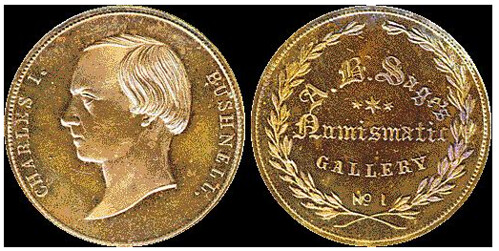
Ira S. Bushnell, a New York City attorney, was a leading numismatic scholar in the 1850s. Many of his findings were published years later in 1875 by S.S. Crosby in Early Coins of America. Bushnell’s pioneering An Arrangement of Tradesmen’s Cards, Political Tokens, also Election Medals, Medalets, &c. Current in the United States of America for the Last Sixty Years, 1858, set the stage for the widespread collecting of these series.
Augustus B. Sage, a New York schoolteacher with a sharp mind and a love for coins, contributed a series of articles in 1857 to the New-York Dispatch. An anonymous reader, “Numismatist,” took exception to certain of Sage’s comments. Not long afterward Bushnell, who used that pseudonym, became acquainted with Sage and they became friends.
In 1859, Sage, by then the founder of the American Numismatic Society and a leading rare coin dealer, commissioned George H. Lovett to create the Numismatic Gallery series of medals. The first honoree was Bushnell.
Bushnell died Sept. 17, 1880. His magnificent collection was purchased by Lorin G. Parmelee, a Boston numismatist who had a private cabinet second only to that of T. Harrison Garrett in Baltimore. Parmelee extracted pieces of interest and then sold the Bushnell coins to the Chapman brothers — S. Hudson and Henry — who created an auction catalog unlike anything ever seen. More than 140 pages in length and printed on impressively large folio sheets, it described 3,000 lots. Copies with photographic plates were available for the unheard of price of $5 (nearly a week’s wages for a factory worker at the time). Descriptions included extensive historical information.
To read the complete article, see: The Bushnell sale of 1882 (www.coinworld.com/Articles/ViewArticle/the-bushnell-sale-of-1882)
MORE ON THE DRAKE MERCATOR MAP MEDAL
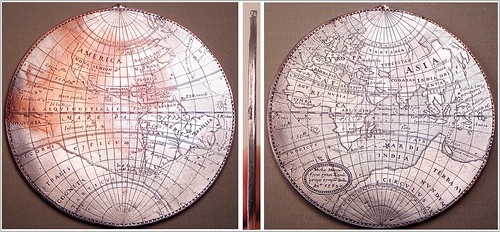
I recently acquired a beautiful example of a Drake Mercator Map medal (Photo attached) from the UK. The example I have is the type with the cartouche on the eastern hemisphere declaring that Mercator made the medal in 1589.
The medal weighs 584 grains, is 68.82mm diameter including the loop, and 67.61 mm at the widest point without the loop. The construction is two soldered plates, measuring 1.4 mm width at the edge. An image of the edge is seen between the two images of the medal. This seems to be one of the later electrotypes made perhaps by Ready at the British Museum (though missing any "R" on the edge as is seen), but at a mere .7mm for each of the two halves, meticulously made.
In researching this medal, I came across numerous references to the medal in the e-sylum, including Alan Weinberg questioning the common claim seen that here are nine examples. If in fact there are hand engraved examples, then there may well be less than nine authentic examples, but The Library of Congress has two examples from the Kraus Collection, one of each type, and on their site actually has a listing of the nine known examples here (see number 58 on this web page): www.loc.gov/rr/rarebook/catalog/drake/drake-catalogue.html#MEDALSANDPORTRAITS
To quote them:
"The copies now known are:
H. P. Kraus, no. I. The example here described. 383 grains; with tang. Unique example, inscribed with the cartographer's name and the date 1589. Probably the prototype.
H. P. Kraus, no. 2.410 grains; with tang. [See No. 58a.]
British Museum, no. 1 (1882.5.7.1). 300 grains; with tang. Probably the first example to be properly described (by Sir Wollaston Franks, 1874).
British Museum, no. 2 (1891.9.5.12). 260 grains; with tang. Also located by Sir Wollaston Franks: "somewhat battered and slightly broken," according to Miller Christy (p. 3).
(Sir John Evans?)--Lord Dillon--J. G. Murdoch. 424 grains; with tang. Possibly the one described by Evans in 1906.
National Maritime Museum, Greenwich, no. 1 (A.4, 1934-49). 326 grains. Purchased 1934: provenance unknown.
National Maritime Museum, no. 2 (A.4, 42-136). 275 grains. Presented in 1942, through the agency of Earl Mountbatten; earlier provenance unknown.
A specimen reported by Lord Milford Haven (1919) and Henry K. Wagner (1937) as being in the possession of Drake's descendants. 284 grains. Probably the one noticed by Lady Eliott-Drake as at Nutwell Court in 1911 ( The family and heirs of Sir Francis Drake , I, pp 73-74).
Henry C. Taylor collection, New York. 312 grains; no tang."
I located the Sir John Evans example; now apparently down-under at the Library of New South Wales, with this provenance:
“Purchased through Spink & Sons, from the collection of Sir John Evans in 1923 who is believed to have acquired the medal from Mr John. G Murdoch in June 1904 who purchased the medal from Lord Arthur Dillon in 1892.”:
To read the complete article, see: acms.sl.nsw.gov.au/item/itemdetailpaged.aspx?itemid=825796
It is worth noting that the Library of Congress site includes a discuss the construction of the medal, with the earliest and most recent studies concluding that the medals are in fact die struck or cast and not hand engraved:
"There is considerable variation in the weight of the known examples of the Silver Map, the lightest weighing 260 grains, the heaviest 424 grains. The present example is intermediate; it weighs 382 grains. There is much doubt as to the method by which the medallions were made. Miller Christy, author of the earliest detailed study, refers to it as "cast or struck" and to the "die or mould" used in its preparation. Lord Milford Haven remarks that "it was at one time believed that these pieces had been struck with a die in imitation of engraving, but a recent careful comparison showed that each had been engraved by hand." A. M. Hind the latest authority, is equivocal, remarking that this and similar pieces "were multiplied either by striking afresh with a die taken from the original engraved counter, or by repeated engraving with the aid of paper or vellum prints from the original impressed on the new surface as a guide to the engraver".
For me personally, having never seen any example of any of them other than the low-resolution images on the internet at the Library of Congress, National Maritime Museum, British Museum, and Library of New South Wales, I have no way to judge what is engraved or cast or struck.
As far as the example I have in hand, I know it has been said that that an electrotype can be precise down to a molecule - but it is impossible to make a matrix accurate to the original down to a molecule of tolerance, so electrotypes are always inferior to originals because of the matrix being only an impressed copy, usually created by hand. I have seen Ready electrotypes, and they are excellent in quality, but still notably inferior to the originals. This example at 584 grains is heavier than any of the nine examples listed above, so the weight certainly points to the possibility of an electrotype, but I have never seen any electrotype constructed out of two pieces that is this thin and detailed. From what I can tell even an electrotype is prohibitively rare, and other than electrotypes at the NMM and the ANS (and presumably the British Museum), I know of no other examples in private hands. The photo speaks for itself - this is a lovely piece - and a worthy addition to my collection!
From a cursory comparison of images I have located on the internet, I agree that they seem to be precise copies of each other, as the example I have matches all the others with a cartouche, including the electrotype at the NMM (though it is worth noting that the NMM electrotype has a smaller stated diameter of only 66mm).
Clearly more study needs to be done to see if there are in fact any engraved examples of these medals, and to sort out the method in which these were created. Without this detailed study, it is impossible to know what is authentic and what is not.
I thought this should also be added to the mix into the discussion regarding whether an engraved Drake Mercator Medal exists. On the British Museum website page showing the A.W. Franks example without the cartouche, they address this:
www.britishmuseum.org/explore/highlights/highlight_objects
/cm/c/cast_silver_plaque_depicting_t.aspx
The medal(s) they have are not engraved, and this is their stated conclusion about the construction of these medals:
"Although at first sight they appear to be individually engraved, Mercator issued a group of silver maps as an edition. The few examples that survive today copy each other exactly in every detail. Mercator must therefore have developed a technique for producing multiples. Although it is sometimes assumed that they were struck using engraved dies (a technique quite close to the printing of maps), examination under a microscope shows that they were actually cast, presumably from an engraved original. This method was later used by the de Passe family for the production of silver portraits of the Stuart royal family."
If in fact the Mercator medals in the incredible cabinet of the British Museum are not engraved, then I am leaning towards believing that none of the medals are hand engraved as stated by both the Library of Congress and the British Museum. websites. In addition to the Stuart medals mentioned, there was also a similar struck or cast medal made of Elizabeth I (by Crispin I van de Passe) emulating an engraved medal, but it is attributed to the early 17th century. In Medallic Illustrations, however, there are other struck or cast medals shown from the same 1580's period as the Drake Mercator medal which do emulate engraved medals, including a 1586 counter for James VI of Scotland (MI I 137/94) and a 1588 counter for Sir Thomas Heneage (MI I, 151/24); so the technology to strike or cast medals emulating engraved medals did exist at this same time.
To read an earlier E-Sylum article, see: DICK JOHNSON ON HOW THE MERCATOR MAP MEDAL COULD BE REPRODUCED (www.coinbooks.org/esylum_v13n25a23.html)
THE BOOK BAZARRE
ARTICLE REVIEWS NEW TOWER OF LONDON MINT EXHIBIT
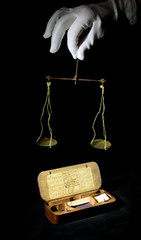 Historic Royal Palaces in partnership with the Royal Mint Museum has launched on May 24, 2013 a new permanent exhibition at the Tower of London. Located on the historic site that was once the country’s Mint for over 500 years (c1279-1812), ‘Coins and Kings: The Royal Mint at the Tower’, will explore the long history of this institution and its connection to London’s premier fortress.
Historic Royal Palaces in partnership with the Royal Mint Museum has launched on May 24, 2013 a new permanent exhibition at the Tower of London. Located on the historic site that was once the country’s Mint for over 500 years (c1279-1812), ‘Coins and Kings: The Royal Mint at the Tower’, will explore the long history of this institution and its connection to London’s premier fortress.
Visitors will be able to explore five pivotal ‘moments’ from the history of the Mint, including Isaac Newton’s efforts to rid London of counterfeiters, when he was Warden of the Mint. Other stories will chart Edward I’s harsh punishments for people who tampered with his coins, Elizabeth I’s restoration of the coinage following her father Henry VIII’s disastrous meddling, and Charles II’s rejection of Commonwealth money.
Star objects include a rare silver Edward I groat (1279-1307), Henry VIII gold trial plate (1542), and a Charles II petition crown (1663); a coin that was never actually in circulation but was designed by Thomas Simon, formerly Chief Engraver to Oliver Cromwell. Simon was so determined to engrave Charles II’s currency that he sent the king one of these beautiful coins to demonstrate his skills. Yet, despite his efforts, Charles gave the job to Dutchman John Roettiers. Sadly, just three years later, Simon fell victim to the plague and died.
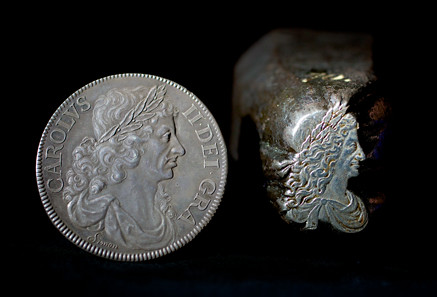
Charles II Petition Crown and Charles II portrait punch
Megan Gooch, Curator at Historic Royal Palaces, said: ‘The Tower is widely known as a palace and a prison, and of course the home of the Crown Jewels, but it was also a hive of industry and The Mint was one of these industries, where most of the nation’s coins were made for over 500 years.
Philip Mernick writes:
Regarding your item on the new Royal Mint exhibition at The Tower of London: It left the Tower around 1809 but only moved to Tower Hill, a few hundred yards away. It didn’t completely leave London until 1975 although its new site at Llantrisant, Wales (10 miles north west of Cardiff) opened in 1968, for the manufacture of Britain’s new decimal coinage.
I saw the new exhibition on its preview day and it certainly is a huge improvement on the previous display in the White Tower. Coincidentally on the 11th Harry & I visited the Royal Mint at Llantrisant as part of a group from the Bexley Coin Club and the Worthing Numismatic Society. We had a comprehensive tour of the manufacturing facilities and also visited the Royal Mint Museum meeting both Dr Kevin Clancy and Graham Dyer.
Our small sub group got to see a variety of interesting items such as the original dies for Pistrucci’s Waterloo medal and dies for striking the 2012 Olympic Games award medals. Also those classic British rarities, 1933 penny and Edward The Eighth patterns.
To read the complete article, see: Tower of London launches new exhibition on historic Mint (www.coinsweekly.com/en/News/4?&id=2070)
LINCOLN CIPHERING BOOK LEAF DISCOVERED
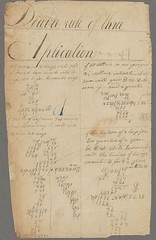 Nerida Ellerton trembled as she held a page from a "ciphering book" written by a teenage Abraham Lincoln as she did research in the archives of Houghton Library at Harvard University.
Nerida Ellerton trembled as she held a page from a "ciphering book" written by a teenage Abraham Lincoln as she did research in the archives of Houghton Library at Harvard University.
However, the Illinois State University mathematics professor did not immediately recognize the significance of what she had in her hand — among the oldest manuscripts written by Lincoln known to still exist.
When Ellerton and her husband, fellow ISU mathematics professor Ken Clements, discovered the document in 2009, "we assumed that its existence was common knowledge," she said Friday at a press conference announcing their findings.
They recently determined it is a missing "leaf" from Lincoln's school workbook, from which it was previously believed only 10 leaves survived.
A "leaf" is a two-sided page and Lincoln's former law partner, William Herndon, had given away these individual leaves as gifts about 10 years after he received the book from Lincoln's stepmother, Ellerton explained.
This particular leaf is believed to be from late 1825, when Lincoln was 16 years old. According to a news release on the Illinois State University website, Lincoln attended schools in Indiana from 1820 to 1826.
Ellerton and Clements not only reconstructed the order of the pages, but also double-checked Lincoln's math, which they declared to be accurate. It showed Lincoln was much more accomplished at math than anyone — including Lincoln himself — gave him credit for, the researchers said.
Stowell said, "As to Lincoln understating his accomplishments, that was fairly Lincolnian."
Lincoln the politician emphasized his railsplitter image, working with his hands, not just sitting behind an office desk, he said.
"That was part of his appeal in 1860," Stowell said of the 16th president.
To read the complete article, see: Illinois State profs find missing page from Lincoln's 'ciphering book' (www.chicagotribune.com/news/local/breaking/chi-abraham-lincoln-ciphering-book-illinois-state-professors,0,6687905.story)
THE BOOK BAZARRE
WAYNE'S NUMISMATIC DIARY: JUNE 16, 2013
Last weekend was a challenging one for The E-Sylum. Knowing I would be away over the weekend I worked hard to have a complete issue ready to publish Friday night. But our mail servers weren't working for me - there was a residual problem from the service company's move to new servers. I notified some NBS officers and frequent contributors and tried all weekend to get help from Tech Support. Their primary email technician was travelling too, and it was Wednesday before I was able to finally publish that issue.
On Tuesday evening I attended a dinner meeting of my Northern Virginia Numismatic Society club, Nummis Nova. It was a sad occasion, having just lost our frequent guest and friend Dr. Richard Doty.
Lenny Goldberg was our host at Pucinella's Italian restaurant in McLean, VA. I arrived around 6pm and people were already beginning to arrive. We had a separate dining room downstairs. I took a seat between Eric Schena and Gene Brandenburg, a wine connoisseur who clearly ended up in the wrong restaurant. As he picked selections from the printed wine list, it felt like the Monty Python Cheese Shop sketch - every item he picked was out of stock. Eventually the waiter brought out four of the bottles they DID have on hand, and Gene picked two of the least bad options. I shared one, and neither of us were impressed. Luckily we had lots of numismatic companionship to make the evening a success. Attending were me, Len, Gene, Eric, Wayne Herndon, Ron Abler, Tom Kays, Mike Packard, Jon Radel, Joe Levine, Dave Schenkman, Julian Leidman, Aaron Packard and Steve Bishop.
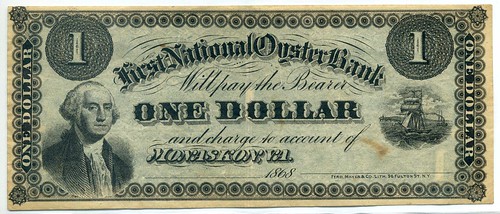
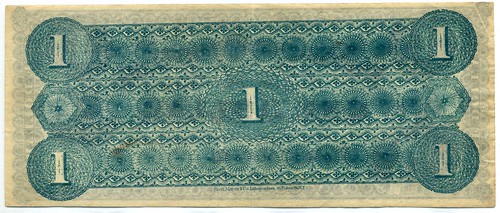
First National Oyster Bank note
Among the first things passed around the table were some paper items belonging to Eric Schena. He writes:
In keeping with the evening's theme of food and drink (sans Chuck E. Cheese tokens), I brought a $1 note from the so-called "First National Oyster Bank" from Monaskon in Lancaster County, VA. The lower denominations are seen every now and again, but the $1 is somewhat scarcer, though a very small number have turned up lately. I have never seen an issued example. It's listed in the Jones/Littlefield Virginia obsolete book (PM60-08 as a 6F) and also the Vlack book on advertising notes (Vlack 4300), which does not list the 10¢, 25¢, 50¢, or $2 notes. I am trying to dig up more information on this rather enigmatic Northern Neck institution.
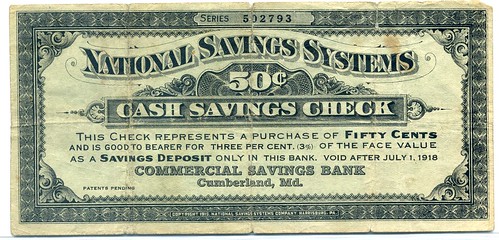
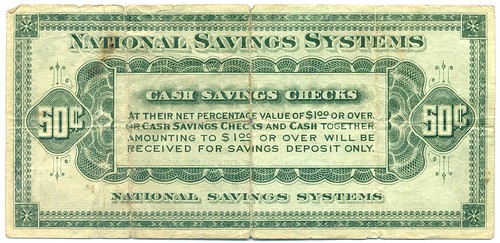
National Savings Systems 50 cent cash savings check
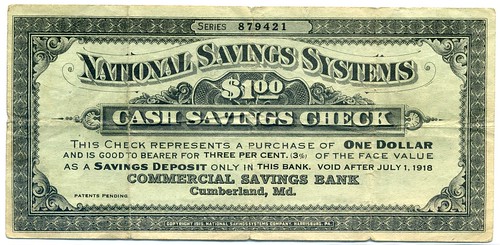
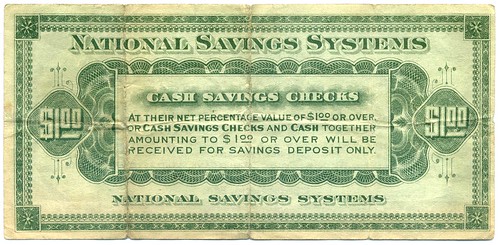
National Savings Systems 1 dollar cash savings check
Eric adds:
I also brought a pair of somewhat mysterious Maryland scrip items: 50¢ and $1 National Savings Systems "cash savings checks" issued by the Cumberland Savings Bank of Maryland. The notes are copyrighted 1915 by the National Savings Systems Company of Harrisburg, PA and bear interest up to July 1918. I have so far not seen any other items like these, nor have I been able to find any more info on National Savings Systems. I brought them since there were a few Maryland numismatists present, but no one seems to have seen anything like them. Anyone else seen these things before? Did they function like Postal Savings System certificates from roughly the same era?
Somehow Eric and I got to talking about early computers and I recommended three books I've read recently:
- Turing’s Cathedral by George Dyson
- The Idea Factory by Jon Gertner
- Tubes by Andrew Blum
I’m partial to The Idea Factory since it's about Bell Labs and I worked there at the beginning of my career. All three are good reads. Tubes is about the hardwire connections making up the internet, their history and the people currently taking care of them. It’s actually very interesting.
Tom Kays can always by counted on for interesting exhibits. He passed around a case containing a nice group of circulated U.S. colonial coins, and a copy of Dave Bowers' Whitman Encyclopedia of Colonial and early American Coins. One of the more interesting pieces was a Fugio cent he'd been unable to attribute using the book. After the meeting he sent images of the coin to Mike Packard for assistance. To writes:
He found it at Stack's online. Q. David B. goofed. The obverse image of the Newman 4E in his pretty Whitman Encyclopedia is wrong. I do have a 4E according to Mike. Good to know.
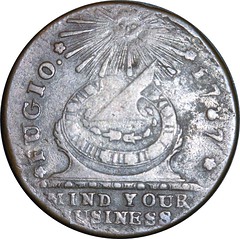
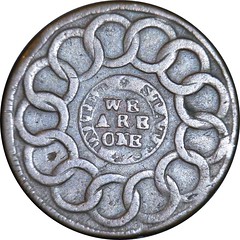
Tom Kays' Newman 4E Fugio
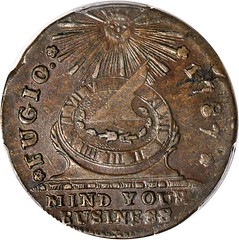
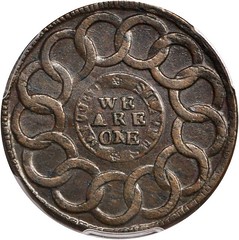
Stack's 1787 Fugio Newman 4-E
To view the complete lot description, see: Lot #6771. 1787 Fugio Copper. Club Rays. Newman 4-E, W-6685. (stacksbowers.com/auctions/AuctionLot.aspx?LotID=409927)
Tom adds:
Anyway, it gave me a thrill to have a colonial coin not listed in the Whitman / Bowers Encyclopedia, if even for an evening. Now I am waiting for the EAC Grading Guide to come out so I can figure out for myself what the most discriminating copper graders would agree it rates. I guess you can’t believe everything written in books, like we can the Internet.
Tom's joking about the Internet. I think. Anyway, I asked him how he assembled the collection. He writes:
Long story. In 1915 my grandfather and his older brother were fed up with cold winters in Ohio, and so they took off on foot to hike the Appalachian Trail down to the southern end and kept going. The left coast of Florida always seemed nice to him after that.
In 1967 Florida land was being purchased by Walt Disney on the QT. My grandfather wanted to buy a parcel down there too and hit upon the idea of roll searching for silver coins, in the hopes they would one day be worth more than face. He had me doing some looking back in the late 1960s, when 4 to 7 silvers were found on average in every roll and 40% was thrown back in the hopes of better.
In 1972 he cashed in and bought his ten acres of sand with silver going for about 1.6 times face. I began “stacking” as he had taught me, on a much smaller scale. Things went real well through the 1970s until the Hunt brothers cornered the market. Silver jumped from 25 times face to near 50 times and then the silver balloon turned to lead, dropping down to around 3 times face at the bottom. It was then I learned not to buy and hold bullion. You buy and sell bullion. You buy and hold rare coins.
I bought a pair of odd variety Fugios in an auction in 1980 and kept going gathering an inexpensive colonial type set, per the front pages of the Red Book. Some of those coins have never been attributed till this last weekend, when I matched them up with the Easy Finder’s Guide in QDB’s Encyclopedia. I still haven’t gotten through the 1787 Connecticut coppers, as they most all look alike to me. Heresy.
Steve Bishop brought a photo mosaic of hobo nickels he admired on eBay. Tom Kays writes:
I think they are undervalued, and some of the modern master carvers are doing wonderful little, URS-1 masterpieces.
With all the activity, I somehow managed to miss a group of token passed around by Aaron Packard. So I asked him for some more information. Neat tokens, and great stories. This is why I've always loved collecting tokens. Be sure to follow the links to his articles for the full stories.
Frank B. Butler's Palace Market - St. Augustine Florida

He writes:
The first were three emissions from Frank B. Butler of St. Augustine Florida. Frank Butler came from very modest beginnings in Georgia and as a young adult moved to St. Augustine. There he learned the Grocer's trade, saved his money, and opened his own Grocery. With the success of his Grocery business he was able to establish a multitude of other business ventures.
Butler was an African American. I found his story compelling because of his humble beginnings, the era, and because it is less frequent to encounter numismatic stories featuring African American merchants. Butler's tokens are patent scrip (Ingle system).
I wrote an article about Butler and his tokens. It appeared in the May 2013 edition of the Florida Token Society's quarterly newsletter 'TokeNews.' The article in its entirety can be found here: www.novanumismatics.com/numismatic-sketches/entrepreneur-frank-b-butler-his-palace-market-tokens/
Here's another token issuer, with a couple interesting varieties.
Smith & Wick's Canning Co. of Baltimore, Maryland
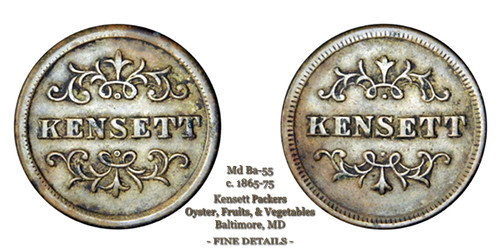
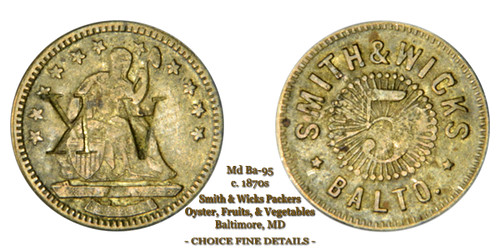
Aaron writes:
The second was an emission from the Smith & Wick's Canning Co of Baltimore MD. Smith and Wick's (a partnership) were very innovative for their day -- not only for their canning processes, but also their ability to reach out to agricultural sources and organize bulk-supply agreements.
For example, Smith & Wick's ventured to The Bahamas, and were able to negotiate a continuous supply of pineapples. This agreement enabled them to offer the American public a steady supply of canned pineapple fruit. Until that time, it was a fruit not frequently enjoyed by many Americans.
The story about Smith & Wicks can be found here: www.novanumismatics.com/numismatics-american-labor/the-smith-wicks-canning-token-of-baltimore-md/
My time at the meeting was truncated, as I had to leave at 8:30 to pick up my son from his basketball practice. But it was a great evening as always, with a great bunch of folks. Many thanks to Eric, Tom and Aaron for contributing to this article.
PITTSBURGH CHRONICLE TELEGRAPH TOKEN FOUND
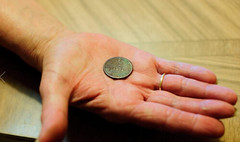 For 10 consecutive years, Henry and Christina Ries have planted fruit and vegetable seeds in their backyard in the spring and reaped the harvest a few months later.
For 10 consecutive years, Henry and Christina Ries have planted fruit and vegetable seeds in their backyard in the spring and reaped the harvest a few months later.
The Carrick couple picked up something unexpected near their zucchini plants while gardening in a new spot in their backyard a few weeks ago.
Henry Ries, 70, found an advertisement token for a newspaper founded in 1884. The newspaper, the Pittsburgh Chronicle Telegraph, was eventually purchased by publishing tycoon William Randolph Hearst.
 The text on the front of the coin says, “If presented at Office of Chronicle Telegraph.” The other side says, “Good for 25 cents on room ads.”
The text on the front of the coin says, “If presented at Office of Chronicle Telegraph.” The other side says, “Good for 25 cents on room ads.”
To read the complete article, see:
Carrick couple uncovers rare coin in backyard
(triblive.com/neighborhoods/alleghenyneighborhoods/
alleghenyneighborhoodsmore/4170793-74/ries-telegraph-chronicle#axzz2WIyEXr6e)
DOG WALKER FINDS 1870-CC DOUBLE EAGLE IN DIRT
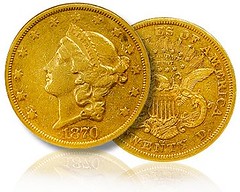 Here in Northern Nevada history can abound in some of the most odd places. Over the years we have see a number of great coins that have been found around the area, literally in the dirt. Some have been found by people using metal detectors while others have been found by people who were just in the right place at the right time.
Here in Northern Nevada history can abound in some of the most odd places. Over the years we have see a number of great coins that have been found around the area, literally in the dirt. Some have been found by people using metal detectors while others have been found by people who were just in the right place at the right time.
Recently a local was walking their dog up in the hills by Virginia City. As they sauntered down the road looking for rocks, one of their favorite pastimes, something caught their eye. In the dirt was a face looking back up at them. Bending down and picking up the coin it was easily discernible as gold due to the weight alone. After wiping off the dirt, which is a big no no, they discovered it was a coin minted in 1870.
Being that the coin had been minted in Carson City it truly became a treasure. It ended up being worth in the five figures. Due to the condition that coin had probably been lying there in the dirt since 1870 just waiting 140+ years for someone to find it.
Finding coins lost in the ground is not uncommon throughout the world, but in this area we have a relatively unique combination that can really spice up a find. In the late 1800′s the west was still untamed and without infrastructure, but there were thousands of people combing the hills in search of fortune and a new life. Many of these miners and explorers lived in crude or very temporary structures. Often the miner would have to find a way to store his wealth without leaving at risk of being stolen. Burying his poke was a common way to hide it from prying eyes. Another way was to sew coins into clothing or saddlery so that it would always be close by.
The second part of the uniqueness to the area is that many of the coins carried by those living out west were newly minted coins from our western mints. Carson City began in 1870 but made coins in very limited quantities. Many of these coins were used until they were worn out due to the lack of coinage available in the burgeoning westward expansion. Today that means that many of these early coins are worth a hefty price.
When coins were buried it was not likely that they would be forgotten, but many a miner did not come back due to tragedy unforeseen. Some of these treasures are still waiting to be discovered.
To read the complete article, see: Rare Coin History and stories in the dirt (www.coinweek.com/us-gold-coins/rare-coin-history-and-stories-in-the-dirt/)
THE BOOK BAZARRE
FALKLANDS ISLANDS MARCH REFERENDUM COIN
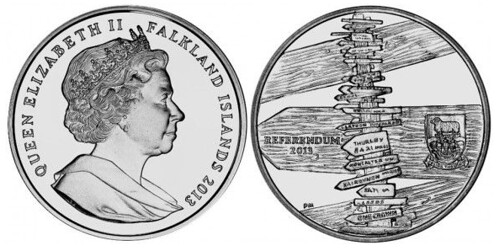
The Treasury of the Falklands Islands Government has issued a new coin whose main focus is that of the March referendum when the population was asked about the status of the Islands and overwhelmingly voted to remain as a British Overseas Territory.
The turnout was 92% and 99% of ballots confirmed British Territory status.
The coin, struck at the Pobjoy Mint, UK is available in both silver and cupro-nickel. The reverse design shows the famous World Directions Signpost near Stanley on the Falkland Islands that was erected by servicemen during the Falklands War which was fought in 1982. The obverse of the coins portrays a fine effigy of Her Majesty Queen Elizabeth II by Ian Rank-Broadley.
The silver crown is .925 silver, 28 grams, 38.6 mm. diameter with a mintage of 10.000 pieces. The cupro-nickel option weighs 28 grams and 38.6 mm and unlimited mintage.
To read the complete article, see: Falklands celebrates March referendum success with a new coin issue (en.mercopress.com/2013/06/12/falklands-celebrates-march-referendum-success-with-a-new-coin-issue)
WORK CONTINUES ON CELTIC COIN HOARD FOUND IN JERSEY
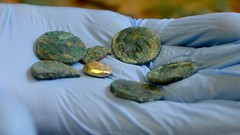 A hoard of coins discovered in Jersey one year ago is the "largest in the Celtic world", according to an expert on the island.
A hoard of coins discovered in Jersey one year ago is the "largest in the Celtic world", according to an expert on the island.
Jersey Heritage Trust Conservator Neil Maher has spent the past year creating a model of the one tonne mound of silver and copper coins, gold pieces and mud.
He said: "This is the world's biggest Celtic coin hoard ever, this was a significant part of a tribe's wealth.
"It is also one of the world's biggest coin hoards and certainly the biggest coin hoard found in Britain."
A large mound containing about 70,000 coins was discovered last year by two metal detector enthusiasts.
"Completely by chance in there we found a small gold coin and it is the first gold one we have found.
"There are about 70,000 coins in the hoard but all the ones we have found so far are a mixture of silver and copper.
"Of the ones which fell out one was a small thick gold one which is about 100 years older than the rest of the coins."
He said they had uncovered about 1% of the coins so far and five gold items had been uncovered.
To read the complete article, see: Jersey hoard is 'world's largest' Celtic coin discovery (www.bbc.co.uk/news/world-europe-jersey-22846664)
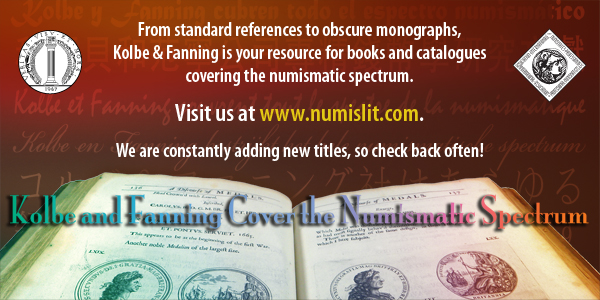
ALASKA'S FORT KNOX GOLD MINE
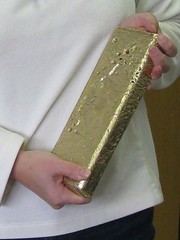 Fort Knox gold mine is located about 25 miles northeast of Fairbanks in the Fish Creek drainage, which has been mined for more than a century.
Fort Knox gold mine is located about 25 miles northeast of Fairbanks in the Fish Creek drainage, which has been mined for more than a century.
It is owned by Kinross and operated by subsidiary Fairbanks Gold Mining Inc.
You won’t find any gold nuggets lying around — the gold at Fort Knox is microscopic — which requires operations on a huge scale to make it economic. Higher grade ore is run through a milling process to extract the gold.

To read the complete article, see:
Unearthing treasure: Fort Knox gold mine by the numbers
(www.newsminer.com/business/unearthing-treasure-fort-knox
-gold-mine-by-the-numbers/article_8da281e6-d3d2-11e2-a863-0019bb30f31a.html)
AN AUSTRALIAN MAN'S SHOCKING STATIC JACKET
An Australian man built up so much static electricity in his clothes as he walked that he burned carpets, melted plastic and sparked a mass evacuation.
Frank Clewer, of the western Victorian city of Warrnambool, was wearing a synthetic nylon jacket and a woollen shirt when he went for a job interview.
As he walked into the building, the carpet ignited from the 40,000 volts of static electricity that had built up.
"It sounded almost like a firecracker or something like that," he said.
"Within about five minutes, the carpet started to erupt," he told Australian radio.
Perplexed firemen evacuated the building and cut its electricity supply, thinking the burns could have been caused by a power surge.
"There were several scorch marks in the carpet, and we could hear a cracking noise - a bit like a whip - both inside and outside the building," said fire official Henry Barton.
Mr Clewer said that after leaving the building, he scorched a piece of plastic in his car.
His clothes were measured by firemen as carrying an electrical charge of 40,000 volts, the Reuters news agency quoted Mr Barton as saying.
To read the complete article, see: Man's static jacket sparks alert (news.bbc.co.uk/2/hi/4252692.stm)
FEATURED WEB PAGE: BUSHNELL BAS-RELIEF BY A. W. JONES
This week's Featured Web Page is a bas-relief of Charles Ira Bushnell (1826-1883), from the New-York Historical Society.
TITLE Charles Ira Bushnell (1826-1883)
DATE 1855-1860
ARTIST/MAKER:Anthony W. Jones
RELATED PERSON:Charles Bushnell
MEDIUM Copper patinated bronze
DIMENSIONS diameter: 7 7/16 in. ( 18.9 cm )
DESCRIPTION Bas-relief portrait
OBJECT NUMBER X.40
MARKS signed: under proper left shoulder: "A. W. Jones Sc"

www.nyhistory.org/exhibit/charles-ira-bushnell-1826-1883
